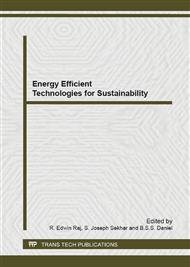[1]
R.D. Misra, M.S. Murthy, Straight vegetable oils usage in a compression ignition engine- A review, Renew Sustain Energy Rev. 14 (2010) 3005-3013.
DOI: 10.1016/j.rser.2010.06.010
Google Scholar
[2]
L.C. Meher, D. Vidya Sagar, S.N. Naik, Technical aspect of biodiesel production by transesterification- a review, Renew Sustain Energy Rev. 10 (2006) 248-268.
Google Scholar
[3]
Md. Nurun Nabi, Md. Mustafizur Rahman, Md. Shamim Akhter, Biodiesel from cotton seed oil and its effect on engine performance and exhaust emissions, Appl Therm Eng. 29 (2009) 2265- 2270.
DOI: 10.1016/j.applthermaleng.2008.11.009
Google Scholar
[4]
Murat Karabektas, The effect of turbo charger on the performance and exhaust emissions of a diesel engine fuelled with biodiesel, Renew Energy. 34 (2009) 989-993.
DOI: 10.1016/j.renene.2008.08.010
Google Scholar
[5]
G. El-Diwani, N.K. Attia, S.I. Hawash, Development and evaluation of biodiesel fuel and by-products from jatropha oil, Int. J. Environ Sci Tech. 6 (2009) 219-224.
DOI: 10.1007/bf03327625
Google Scholar
[6]
Mário L. Randazzo, José R. Sodré, Exhaust emissions from a diesel powered vehicle fuelled by soybean biodiesel blends (B3–B20) with ethanol as an additive (B20E2– B20E5), Fuel. 90 (2011) 98-103.
DOI: 10.1016/j.fuel.2010.09.010
Google Scholar
[7]
Piyali Das, Sreelatha, Anuradda Ganesh, Bio oil from pyrolysis of cashew nut shell-Characterization and related properties, Biomass Bioenergy. 7 (2004) 265-275.
DOI: 10.1016/j.biombioe.2003.12.001
Google Scholar
[8]
A.P. Maharnawar, Characterization and processing of CNSL, Master of Science (Technology) thesis, University of Bombay, India (1994).
Google Scholar
[9]
Risfaheri, Tun Tedja Irawadi, M. Anwar Nur, Illah Sailah, Isolation of cardanol from cashew nut shell liquid using the vacuum distillation method, Indo. J. Agriculture. 2 (2010) 11-20.
Google Scholar
[10]
Piyali Das, Anuradda Ganesh, Bio oil from pyrolysis of cashew nut shell-a near fuel, Biomass Bioenergy. 25 (2003) 113-117.
DOI: 10.1016/s0961-9534(02)00182-4
Google Scholar
[11]
Jinlin Xue, Tony E. Grift, Alan C. Hansen, Effect of biodiesel on engine performances and emissions, Renew Sustain Energy Rev. 15 (2011) 1098–1116.
DOI: 10.1016/j.rser.2010.11.016
Google Scholar
[12]
Murat Karabektas, Gokhan Ergen, Murat Hosoz, The effects of preheated cottonseed oil methyl ester on the performance and exhaust emissions of a diesel engine, Appl Therm Eng. 28 (2008) 2136- 2143.
DOI: 10.1016/j.applthermaleng.2007.12.016
Google Scholar
[13]
Rajesh N Patel, Santanu Bandyopadhyay, Anuradha Ganesh, Extraction of cashew nut shell liquid using Supercritical Carbon dioxide, Bioresource Technol. 97 (2006) 847- 853.
DOI: 10.1016/j.biortech.2005.04.009
Google Scholar
[14]
D.N. Mallikappa, Rana Pratap Reddy, Ch. S.N. Murthy, Performance and emission characteristics of double cylinder CI engine operated with cardanol bio fuel blends, Renew Energy. 38, (2012) 150-15.
DOI: 10.1016/j.renene.2011.07.012
Google Scholar
[15]
K. Anand, R.P. Sharma, Pramod S. Mehta, Experimental investigations on combustion, performance and emissions characteristics of neat karanji biodiesel and its methanol blend in a diesel engine, Biomass Bioenergy. 35 (2011) 533-541.
DOI: 10.1016/j.biombioe.2010.10.005
Google Scholar
[16]
Suyin Gan, Hoon Kiat Ng, Effect of antioxidant additives on pollutant formation from the combustion of Palm oil metyl ester blends with diesel in a non- pressurised burner, Energy Convers Manage. 51 (2010) 1536-1546.
DOI: 10.1016/j.enconman.2010.02.012
Google Scholar
[17]
J. SadhikBasha, RB. Anand, Role of nano additive blended biodiesel emulsion fuel on the working characteristics of a diesel engine, J. Renew Sustain Energy. 3 (2011) 106- 124.
Google Scholar
[18]
T. Pushparaj, U. Omezhilan, V. Arumugham, S. Ramabalan, Performance and emission studies on an agriculture engine on karanja biodiesel with bio fuel enhancer additives, CIIT Int. J. Automation Autonomous systems. 3 (2011) 331-336.
Google Scholar
[19]
V. Palvannan, K. Balagurunathan, Technical Sustainability of Cashew Nut Shell Liquid as a Renewable Fuel in Compression Ignition Engine, Euro J. Scientific Research. 76 ( 2012) 614-627.
Google Scholar
[20]
T. Pushparaj, S. Ramabalan, Influence of CNSL biodiesel with ethanol additive on diesel engine performance and exhaust emission, Int J. Mechanical Engg Tech. 3 (2012) 665-674.
Google Scholar


